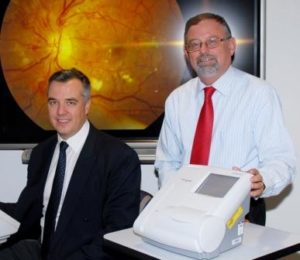
A successful diabetes management program run by Flinders University in rural and remote Indigenous communities may soon link with a critical eye screening service.
QAAMS (Quality Assurance for Aboriginal and Torres Strait Islander Medical Services) is a national service, established by Professor Mark Shephard at Flinders in 1999 and funded by the Federal Government, that provides point-of-care pathology testing (POCT) for diabetes management at over 170 Aboriginal and Torres Strait Islander medical services where healthcare professionals (mainly Aboriginal Health Workers) are able to assess and treat diabetes patients on the spot.
The program has seen reductions in haemoglobin A1C levels, which indicate an improvement in glycaemic control in patients with diabetes and lead to a reduced risk of complications from the disease.
Director of the Flinders University International Centre for Point-of-Care Testing, Professor Shephard said point-of-care testing works well because it is not only convenient and accessible but culturally appropriate, too.
“The patient comes into the service, has just a finger prick of blood taken and tested by a trained Aboriginal Health Worker, and gets a result in less than 10 minutes,” he said.
“The difficulties Indigenous people often have because of other social and cultural priorities around coming back for a follow-up visit are taken out of the equation: they get their result there and then, and they can have their treatment managed at the same time.
“The average time in a sub-set of Aboriginal patients from the Northern Territory to come back to their health centre for a laboratory result was 27 days. In our point-of-care process, it’s six minutes.”
Professor Konrad Pesudovs, head of the Department of Optometry and Vision Science at Flinders, said diabetic retinopathy screening would be undertaken later this year at a number of sites where the QAAMS operates.
The collaborative plan allows for trained Aboriginal Health Workers to take retinal photos which could then be graded and reported on at the Department’s telemedicine laboratory at Bedford Park and thereby significantly boosting the detection and treatment of diabetic retinopathy – a serious eye disease.
“Australian towns and cities of less than 10,000 people simply do not have an optometrist which means people have to travel for eye care. All of the studies suggest that 50 per cent of people with diabetes already do not get eye examinations at appropriate intervals,” Professor Pesudovs said.
“While telemedicine and tele-ophthalmology are not novel, finding a service delivery method that works is key,” he said.
“A retinal examination would be an augmented service for the patients who are currently being seen in QAAMS. I see it as a terrific way to improve the care for people with diabetes.”
Professor Pesudovs said the advantages of delivering diabetic retinopathy screening through QAAMS were the program’s quality assurance, oversight, accreditation and training systems.


Diabetes, often referred to by doctors as diabetes mellitus, describes a group of metabolic diseases in which the person has high blood glucose (blood sugar), either because insulin production is inadequate, or because the body’s cells do not respond properly to insulin, or both. Patients with high blood sugar will typically experience polyuria (frequent urination), they will become increasingly thirsty (polydipsia) and hungry (polyphagia).^*.`
See ya later
http://homelifestylejournal.comdj Meg Bottalico